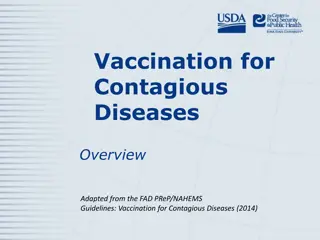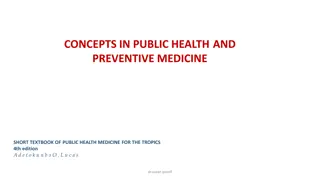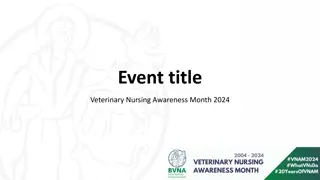Overview of Schistosomiasis and Fascioliasis in Veterinary Medicine
Schistosomiasis and Fascioliasis are important parasitic diseases affecting animals, particularly ruminants and horses. Schistosomiasis, caused by Schistosoma species, can lead to severe symptoms such as diarrhea, weight loss, anemia, and eosinophilia. On the other hand, Fascioliasis, caused by Fasciola hepatica and Fasciola gigantica, affects the liver of animals, leading to significant economic losses in livestock. Understanding the life cycle, transmission, and clinical signs of these diseases is crucial for effective diagnosis and control measures in veterinary practice.
Download Presentation

Please find below an Image/Link to download the presentation.
The content on the website is provided AS IS for your information and personal use only. It may not be sold, licensed, or shared on other websites without obtaining consent from the author.If you encounter any issues during the download, it is possible that the publisher has removed the file from their server.
You are allowed to download the files provided on this website for personal or commercial use, subject to the condition that they are used lawfully. All files are the property of their respective owners.
The content on the website is provided AS IS for your information and personal use only. It may not be sold, licensed, or shared on other websites without obtaining consent from the author.
E N D
Presentation Transcript
Schistosomiasis Dr. Bipin Kumar Assistant Professor Department of Veterinary Medicine Bihar Veterinary College, Patna (Bihar Animal Sciences University, Patna)
Trematodes Schistosomes: Blood flukes Family: Schistosomatidae Genus: Schistosoma For animals(ruminant & horses) : Sch. bovis, sch. Mattheei, sch. Spindale, sch. nasalis, Sch. margrebowiei Disease : Bilharziasis or Schistosomiasis
Introduction Fascioliasis is called as liver fluke disease or liver rot Fasciola hepatica: Mostly found in temperate and cooler area of high altitude in tropical and subtropical countries Fasciola gigantica: Mostly in tropical countries Morphology Broad-leaf like body Host affected Natural host: Cattle, Buffalo, Sheep, Goat and Other ruminants Unusual host: Horse & Man Location Immature flukes: Small intestine, peritoneal cavity and liver parenchyma Mature flukes: Bile duct
S. nasale inhabits blood vessels of the nasal mucosa and causes "snoring disease" in cattle. symptomless in buffaloes though extruding its eggs in nasal discharge. intermediate host is a freshwater snail Indoplanorbis exustus.
Life Cycle, Transmission, and Epidemiology Schistosomes live in the mesenteric and hepatic veins (except for S nasale, nasal veins). Eggs passed in the feces releases miracidia, which invade suitable water snails and develop through primary and secondary sporocysts to become cercariae. When fully mature, the cercariae leave the snail and swim freely in the water, where they remain viable for several hours. Animals are infected with cercariae through skin, although infection may be acquired orally while animals are drinking. During penetration, cercariae develop into schistosomula, which are transported via the lymph and blood to their predilection sites.
Signs and symptoms Visceral Schistosomiasis: The disease is characterized by diarrhea, weight loss, anemia, hypoalbuminemia, hyperglobulinemia, Severe eosinophilia that develop after the onset of egg excretion. Severely affected animals deteriorate rapidly and usually die within a few months of infection. Less heavily infected develop chronic disease with growth retardation.
Nasal Schistosomiasis cauliflower-like growth or granuloma in the nasal cavity. "snoring" sound and profuse mucopurulent.
Diagnosis By eggs in the faeces. Microscopic examination of the mesenteric veins for the presence of adult worms. Microscopic examination of scrapings of the intestinal mucosa or of crushed liver tissue (both for eggs). Eggs of S bovis, S curassoni, and S mattheei are spindle- shaped. Eggs of S nasale are boomerang-shaped while oval type of S japonicum.
Treatment&Control Anthiomaline was the drug of choice, but this leads to relapse of the symptoms after two months of the treatment. Praziquantel@25mg/kg proved better than any other drug. Triclabendazole @10mg/kg. Snail control.























